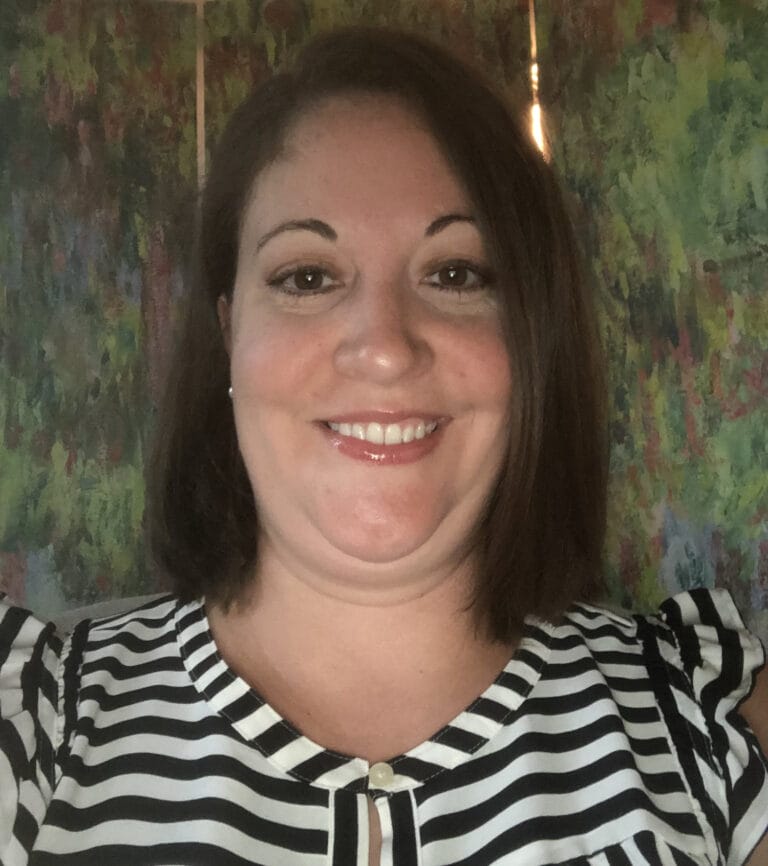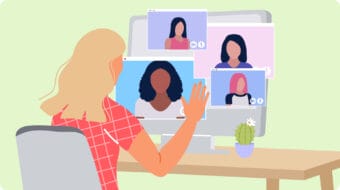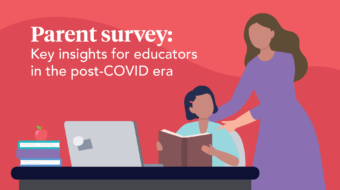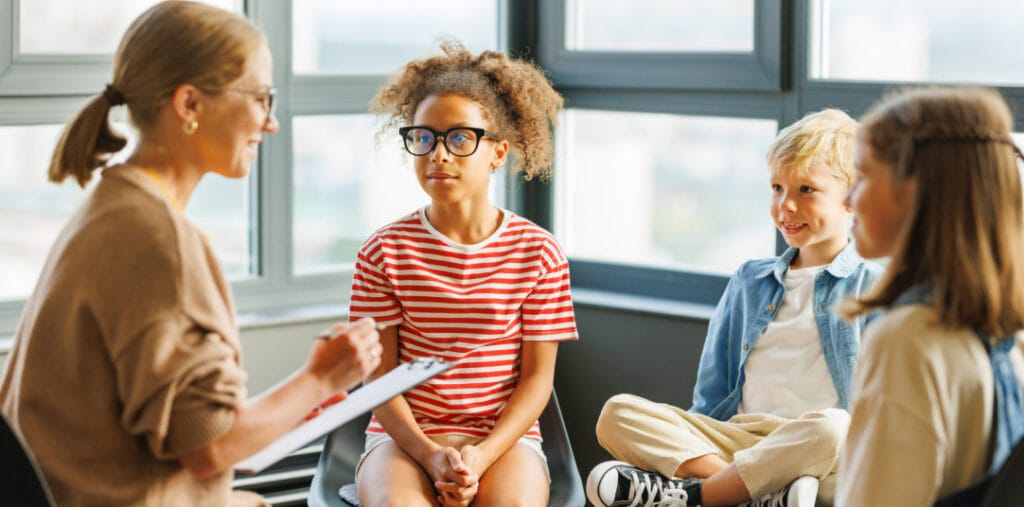
Introduction
Jessica L., MA, CCC-SLP, grew up in upstate New York. She.attended Elmira College in Ithaca, New York from 2002 to 2006 and received her undergraduate degree. She graduated from Syracuse University in 2008 with her graduate degree in Communication Sciences and Disorders. Jessica started her career as a speech-language pathologist in New York, and moved to Pennsylvania where she lives and works today. She joined the PresenceLearning Care Network at the start of the 2020–2021 school year, and has been an SLP for 12 years.
What inspired you to become an SLP?
You could say I fell into the family business. My dad is a retired school administrator. He was not only my middle school principal, he was also the assistant superintendent at my district. My mom is a retired reading teacher. Working in pediatrics was my thing. I would volunteer in my mom’s classroom and I would always see the speech language pathologist. I thought that was something I’d be good at. I’m very creative and artistic. I get the science side because I like medical and science, but I’m also creative in how I think and process information. I use that, especially with a lot of kids on the spectrum—I can really relate to music or creative things. I like to do crafts with my own son, or things like that where I can use a lot of my talents in different ways.
What made you want to be a teletherapist with PL?
I’ve been all over the place career wise. Most recently I worked in a medical setting which brought me here. During the pandemic, the only places that were open were inpatient settings. They closed all the outpatient settings. I was furloughed temporarily. My husband works from home. It seemed like he has a good work-life balance so I put that in the back of my mind.
When I was called back, I temporarily worked as a COVID screener in the emergency department. It was OK. But I didn’t know how long it might go on before we got our caseload back, and I was unsure why we weren’t going to teletherapy since that’s where we should have gone. You don’t want to just go through the motions. Being a speech pathologist is what I was born to do so I wasn’t going to just bide my time. I figured I’d make the change and see how it goes. I feel like I am really well-suited to teletherapy. I transition easily. First I was in a school setting and then I went into the medical setting. I’ve tried to reinvent myself. That is what keeps the career interesting and what challenges me. My eclectic nature is only a strength because I can pull from my different experiences and patient populations to help the students.
How did you connect with PL?
Given I was such a novice, PL has been around the longest and was the most seasoned so I felt like I wanted to learn from the best—the company with the most seniority and the platform and all the resources. I didn’t want to get myself into something that was a hodgepodge that’s just thrown together. I wanted to feel like I was going to be mentored, and feel confident that this is how it should be done.
What do you enjoy about being a provider with PL?
I really enjoy working as a PL provider. I get a sense of fresh air from trying to do different things. I like to challenge myself to find new ways of doing things. For example, I like to think about how to use low tech things in a high tech environment. This past weekend we took our son to the Indian Echo Caverns. I know a lot of kids are into Minecraft. I put together a little iMovie trailer with my pictures from the weekend and put in funny Minecraft things and gifs. It engages that conversation of how you can use things about yourself during therapy. I find that really interesting. The kids are responding really well to the different materials when I use the document camera, or any of the tons of things on the platform, or Screenshare and SiteShare. When I plan my sessions, there are so many things I can do. I ask myself how can I put in just 30 minutes when there’s so much I want to do. The freshness of it is really exciting.
What were you most surprised about when you made the transition to be a teletherapist?
Honestly, I think I was a little worried about the technology end, like working with a second monitor. But once you get that motor plan down, you can get up and running quickly. If you’re a millennial or you’re used to using technology, it comes pretty easily. Once you get in a rhythm, it’s actually pretty user friendly, at least for right now. I find I spend less time with documentation now than in a brick-and-mortar setting.
What do you find most challenging about being a teletherapist?
I have one student who wouldn’t turn his webcam on and he wouldn’t verbally speak back to me. He’ll type back to me to respond. I’ve seen him three times so far. I would show him funny videos I created. He would type to me and we’d use emojis. Today was the first day he turned his webcam on and talked to me. So I’ve learned that some of the kids might be in a different environment—maybe they’re a little uncomfortable at first given the distance. Some students might need a little warming up to the process because they’re a little wary at first. He’s the only one.
In general, for teletherapy, I find the kids are a lot more talkative and outgoing the first day. When I worked in the medical setting, the kids would frequently be selectively mute. They’ve had a lot of medical issues and they don’t know what you’re going to do with them. They’re very stand-offish. But if they’re in their home, their learning coach is there, their pets are there, they’ll talk to you for days so you get a great language and speech sample instead of pulling teeth. So I would say teletherapy is a lot easier for getting to know the kids on their own turf.
How did your practice change during the COVID-19 crisis? Did you transition to working in homes?
In the summer I did most of my onboarding so I didn’t start until the new school year with PresenceLearning. I work with a virtual charter school so the students are used to the virtual setting already in the home.
How has this transition been for you and for your students and their families? It would be good to know what some of the challenges have been and how you’ve worked through those challenges, when applicable.
I had been a medical SLP in the pediatric outpatient setting for 8 years (after previously working in home-based EI/preschool and brick-and-mortar school-age settings for 4 years.) When all of the non inpatient clinical settings were closed in my hospital system in March 2020, as I mentioned, I was furloughed for a few months. I enjoyed the time at home with my 3-year-old son immensely. We did all the things including backyard safari animal hunts, making bath bombs, letter-of-the-day themed lunches, virtual zoo talks, preschool Zoom classes, and making quarantine survival salt dough medals! I was “recalled” back to my job in mid-June but as a COVID screener and not an SLP. After 3 weeks of screening employees and patients for COVID-19 symptoms, I decided to pivot to virtual therapy and PL was my top pick. My husband helped me order and set up my home office, and I am loving the change to teletherapy!
Could you walk us through your daily routine? A “day in the life of a PL therapist” if you will?
I work part time. My son goes to an in-home daycare that only has a few kids so he has his routine. Usually I help get my son ready for preschool or daycare. It’s a really nice life work balance. I’ll often throw in a load of laundry or vacuum. I’ll log in to see what I have email-wise. Right now I don’t have students until 10 or 11 am which is great so I’ll plan for the day. For the most part my students are one-on-one which is very manageable. I feel like they really get individualized attention. Around lunch time, since my husband works from home, we eat lunch together and I take my dog out for a walk which is nice. In general, afternoons are pretty busy with students. I usually finish up no later than 4:30 or so. The documentation, once you get in a rhythm, goes pretty quickly. I like to get it all done by the end of the day so I don’t have anything carried over. I’ll pick up my son from day care and we’ll go on a little adventure—we’ll go on a hike, or we’ll go by the lake. I’m really creative so we’ll do a lot of crafts. The other day we made a volcano out of a pumpkin with citric acid and baking soda. Practicing teletherapy with PL provides the life-work balance that I’ve always desired. I distinctly remember when my CAM (Clinical Account Manager) asked me what my “hard stop time” was. Never in my professional life had anyone asked me when I wanted to be finished with work for the day.
When I have any time to myself, I like to go on hikes or do something outdoors. I like to do special projects for other people like sending care packages or doing some kind of charity work. Last week I gathered things for Operation Christmas Child or I’ll make a drop to the food bank or I’ll deliver a care package to someone having a hard time in the pandemic who needs a pick-me-up.
How have you been helping parents and caregivers who are now acting as the primary support person with their child?
I think it’s important to recognize the enormous pressure that parents and caregivers are under during this unprecedented time and to lead with understanding and empathy—lending an ear if they need to vent or offering a joke or funny story to add levity. I do my best to make sure that they are comfortable with the technology, know where to save/access the link, have a regular therapy time that doesn’t conflict with any of their work meetings, and remain flexible with therapy activities if the child is having an “off day.”
I do a bit of handholding in the virtual school in the beginning. I’ll send the parents a reminder so they don’t forget the session. I try to acknowledge with them that we’re all just trying to do our best.
What age range/student population are you currently serving? Please include demographic information.
I’m currently working with students in Kindergarten to 12th grade.
What tips do you have for other providers getting started with telepractice?
Try to add one new piece of technology at a time not to overwhelm yourself. Befriending other new or seasoned PL providers is enormously helpful as well as attending many open office hours with Gila Cohen-Shaw and the wonderful clinical workshops. (You can read a PresenceLearning Spotlight with Gila Cohen-Shaw here.)
I have a serendipity story to share about connecting with other PL providers. When I first started, I was spending time in the PL provider Lounge and I asked if anyone was a new provider in Pennsylvania. I wrote that I was new but I’m a nerd so I’d make an excellent study buddy. I was hoping to reel somebody in. One provider reached out to me saying she’s not new but she’s definitely nerdy. We video chatted and we’ve kept in touch.
Meanwhile, I was assigned to my first virtual school but I didn’t feel like it was a great fit for me. I didn’t want to be a problem child but I’d just quit a job that I loved and wanted to make sure I had a school that fit my skills. So I was assigned to a different charter school which I love and my provider friend was there! So we’re working in the same charter school together.
I have a couple of friends I met in the provider Lounge who became my practice buddies—we’d reach out to practice tests together. I have a few friends I met that way and we’ll reach out to check on each other. I’m pretty new in my district now. But at my last district I tried to make a point to reach out to other providers in the district to create that camaraderie. Even if you have one friend you check in on…that helps. It really helps to have a practice buddy, especially in the beginning when you don’t know what you don’t know. It’s great to have somebody else to keep that check and balance.
Are you interested in joining the PresenceLearning Care Network? Click here to start your application.



